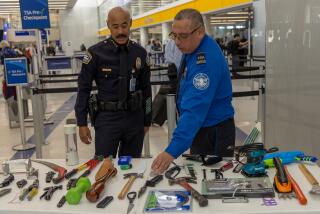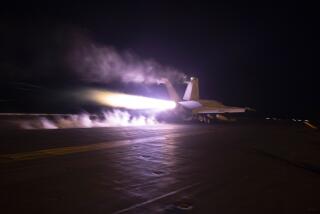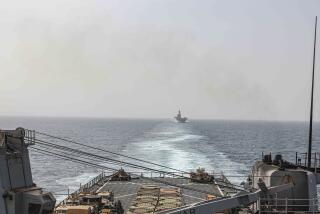U.S. steps up screening as debate flares about cargo security
- Share via
Reporting from Washington — U.S. officials dramatically increased the screening of incoming air cargo after the interception Friday of two explosive devices believed to have originated in Yemen, as a renewed debate emerged over how many resources federal officials and private companies should devote to such screening.
The packages from Yemen contained chemical explosives camouflaged as printer cartridges and wired to be detonated by a cellphone. They were found in Dubai, United Arab Emirates, and England only after the U.S. received a tip from Saudi Arabia.
“Without this intelligence, it is likely they would have slipped through the security measures we have in place,” said U.S. Rep. Michael McCaul (R- Texas), a Homeland Security committee member who was briefed on the plot.
He said the bombs “have exposed a weakness in the way that cargo is screened on its way to the U.S.” and that terrorists have identified that vulnerability. “This opens everybody’s eyes up,” McCaul said.
The U.S. checks incoming foreign parcels using a network of government-certified private screeners and companies as well as its own inspectors at about 18 gateway airports around the country, according to the Transportation Security Administration.
As of August, about 38% of cargo coming into the U.S. was not being screened, according to the TSA.
The bomb plot is likely to spark a call in Congress to push for 100% screening, McCaul predicted Saturday. One challenge, he added, will be how “to balance security and commerce on this matter.”
The sheer numbers of packages flowing through the $100-billion global air freight industry is daunting. UPS, which was the courier for one of the explosive packages and had three planes inspected at U.S. airports on Friday, ships 15 million parcels a day worldwide. FedEx, which was transporting the other package, ships about 8 million.
“We have to find that balance” between security and a timely operation, said UPS spokeswoman Karen Cole. “We have a lot of security checkpoints and systems to make sure that network is secure.”
Shipment data are transmitted to the Department of Homeland Security at least four hours before any cargo plane lands on U.S. soil. Department officials then analyze the data about the packages’ origins and destinations to identify “high risk” cargo to be inspected.
In addition, all inbound packages weighing more than 150 pounds are searched, and smaller packages could be inspected by bomb-sniffing dogs while in transit, according to U.S. Rep. Jane Harman (D-Venice), chairwoman of the Homeland Security Intelligence Subcommittee.
Citing security concerns, TSA officials declined to describe the inspection methods. The minimum inspection criteria have been temporarily elevated, officials said.
In June, TSA Assistant Administrator John Sammon told Congress that the agency had a goal of screening 100% of incoming international cargo by 2013.
The TSA has said that effort will be limited by existing technology’s inability to quickly and accurately screen packages as well as the difficulty of relying on screening programs run by foreign governments.
In recent years, the TSA has increased domestic screening programs.
As of August, TSA or certified screeners have been checking all cargo on domestic passenger planes and on international passenger flights to the U.S. that are labeled “high-risk.” The TSA has certified more than 1,200 cargo screening facilities in the U.S.
The mail bomb threat prompted the Department of Homeland Security to roll out additional safety measures at passenger airports. An “unpredictable mix” of security layers for passengers was implemented, the TSA announced, including explosives detectors, bomb-sniffing dogs and additional pat-downs.
More to Read
Sign up for Essential California
The most important California stories and recommendations in your inbox every morning.
You may occasionally receive promotional content from the Los Angeles Times.














